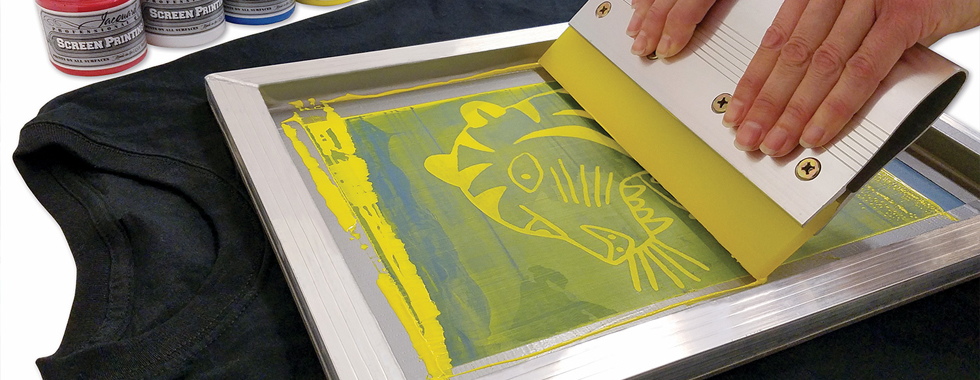The Vital Overview to Comprehending Screen Printing and Its Versatile Utilizes
Screen printing has an abundant history that goes back to old times, advancing into an advanced method utilized throughout various sectors today. This guide checks out the details of the screen printing procedure, outlining its applications in style, marketing, and home design - 10:9 Design reviews. Comprehending these basics can open innovative capacity for both industrial and imaginative projects. The adhering to areas will expose essential pointers and techniques to boost one's screen printing undertakings
The History of Screen Printing
Although screen printing has roots that trace back centuries, its advancement shows the artistic and technical developments of numerous societies. Coming from ancient China, the method was at first used for decorating fabrics and later spread to Japan, where it came to be essential to Ukiyo-e woodblock printing. The approach shifted to Europe in the 18th century, where it got popularity amongst craftsmens and business printers. The invention of photo solution in the 20th century changed screen printing, enabling more intricate designs and higher performance. Artists like Andy Warhol better pushed its popularity, utilizing the tool to develop iconic jobs that mixed commercialism and art. By the late 20th century, screen printing had actually developed itself as a flexible strategy, employed in fashion, advertising, and great art. Today, it continues to advance, integrating electronic modern technology and increasing its applications throughout numerous markets.
The Screen Printing Refine Explained
Screen printing transforms artistic visions right into tangible layouts through a series of exact steps. A picture is produced and then transferred onto a screen, typically made of great mesh material extended over a frame. A light-sensitive emulsion is applied to the screen, which is exposed to light, setting in locations not covered by the image. After washing out the unhardened emulsion, a pattern is developed.
Next, the screen is put over the substrate, whether it be textile, paper, or another material. Ink is after that pressed with the open locations of the pattern making use of a squeegee, transferring the layout onto the substratum listed below. This process can be repeated for multiple colors, needing separate displays for each and every shade. Finally, the printed thing is cured making use of warmth to ensure the ink adheres correctly, resulting in a long lasting, dynamic design on-line.
Kinds Of Screen Printing Techniques

Additionally, specialty techniques, such as discharge screen printing, eliminate dye from the textile to develop softer prints, while aluminum foil screen printing uses metallic aluminum foil to attain a shiny finish (10:9 Design LLC Company). Each strategy supplies unique attributes, catering to numerous innovative requirements and production scales, inevitably expanding the possibilities within the screen printing domain name
Applications of Screen Printing in Numerous Industries

Additionally, the signs and advertising and marketing industries make use of screen printing for developing captivating displays and banners. This technique enables strong colors and elaborate layouts that record focus. In electronics, screen printing is utilized for using conductive inks to motherboard, essential for element connections. The home décor market welcomes screen printing to produce unique styles on textiles and wall surface art. On the whole, screen printing serves as a crucial tool across diverse fields, improving products with customized and visually attractive graphics.
Tips for Successful Screen Printing Projects
While embarking on a screen printing job, cautious interest to detail can significantly enhance the final result. First, selecting premium materials is vital; this includes the screen, inks, and substratums. Using ideal mesh counts can affect ink deposition and information resolution. Prep work is similarly essential; comprehensive cleaning of displays and appropriate exposure times guarantee crisp prints.
Next off, precise registration is crucial for multi-color prints. Utilizing placement devices can help achieve specific layering. In addition, testing prints on scrap materials before production aids determine potential issues without throwing away resources.

Frequently Asked Questions
What Materials Are Ideal for Screen Printing on Textile?
Cotton and polyester blends are ideal for screen printing on fabric because of their longevity and ink absorption. In addition, specialized materials like silk or canvas can create distinct textures and finishes, boosting the total style high quality.
Exactly how Do I Clean and Maintain Screen Printing Equipment?
To preserve and clean screen printing tools, one must consistently clean screens with appropriate solvents, evaluate mops for wear, lube moving components, and store all items in a completely dry, dust-free atmosphere to prolong their life-span.
What Are the Ecological Impacts of Screen Printing?
Screen printing can have significant ecological effects, consisting of chemical waste from solvents and inks, water usage during cleansing processes, and power intake. street sign printing Sustainable techniques and eco-friendly products are vital for minimizing these adverse effects.
Can Screen Printing Be Done in the house Efficiently?
Screen printing can be effectively done at home with the appropriate materials and strategies. Hobbyists can produce top quality prints, though success depends upon other their ability level, devices, and understanding of the process included.
What Are the Prices Related To Beginning a Screen Printing Service?

Beginning a screen printing business entails prices for equipment, materials, and office. First expenditures commonly vary from a few hundred to a number of thousand bucks, relying on the range, quality of machinery, and preferred production capability.
Screen printing has an abundant background that dates back to old times, advancing right into a sophisticated technique used across various industries today. Another technique, rotary screen printing, employs cylindrical screens, helping with constant printing on material rolls, thus improving efficiency for large-scale productions. Additionally, specialty techniques, such as discharge screen printing, remove dye from the material to create softer prints, while foil screen printing uses metal aluminum foil to accomplish a shiny finish. In the fashion sector, screen printing is extensively made use of to produce dynamic designs on apparel, enabling brand names to display their unique designs. Cotton and polyester blends are suitable for screen printing on material due to their resilience and ink absorption.